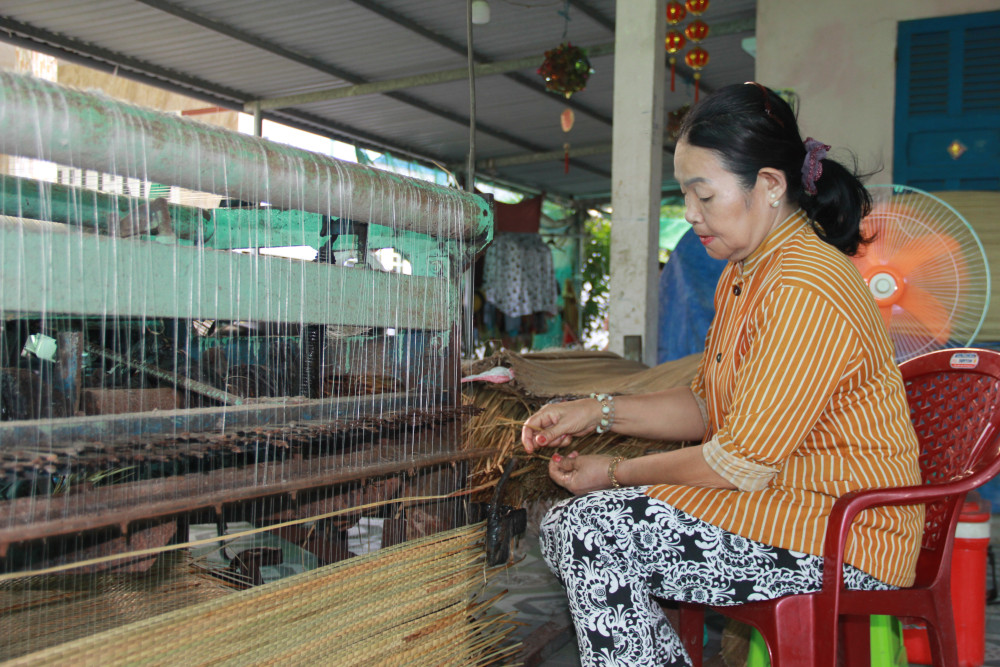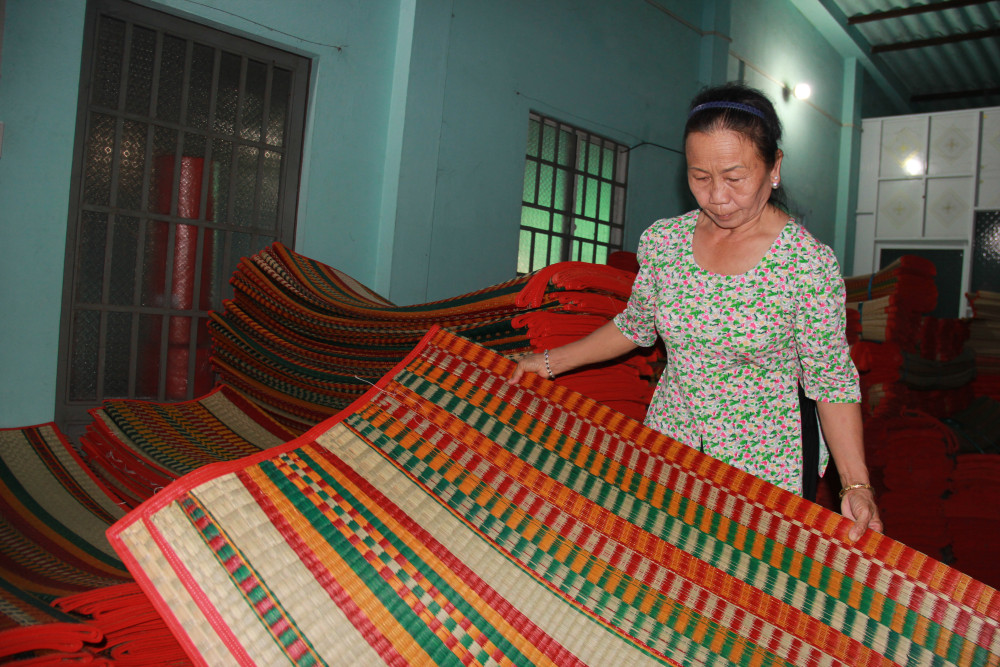1. Mr. Bui Thanh Nhut has more than 30 years of experience making rice paper at Nhon Hoa Rice Paper Craft Village (Ward 5, Tan An City). He is the 3rd generation of his craft household. Mr. Nhut said: "In the past, this area had 8-10 rice paper kilns for every 8 households, but now many of them have stopped and switched to other jobs." Although the traditional profession is gradually fading away, Mr. Nhut still has regular customers thanks to his reputable business. Currently, his customers are in many places such as Can Duoc, Ben Luc, Thanh Hoa districts (Long An province), My Tho city (Tien Giang province), etc.
.jpg)
Workers at Mr. Bui Thanh Nhut's rice paper facility (Nhon Hoa Rice Paper Craft Village, Ward 5, Tan An City)
Every day, Mr. Nhut wakes up at 3am to make dough and then works until 6-7pm. Nhon Hoa rice paper powder must be made from 504 rice with a dry characteristic (sticky rice cannot be used to make rice paper). Nhon Hoa rice paper is square, flexible, not crispy, not dry, and has a salty taste. After being made, the rice paper is dried on a bamboo tray for about 1.5 hours to become the finished product. Households do not use plastic tray because it will make the rice paper crispy, losing its characteristic. According to Mr. Nhut, drying with too much heat will cause the rice paper to shrink, not enough heat will cause the rice paper to get moldy, so Nhon Hoa rice paper needs to be dried in the sun. Currently, his facility has 5 workers, producing about 150kg of rice paper per day. He works all year round, only stopping when it rains and the rice paper cannot be dried. Near Tet, people's consumption demand usually increases, but Mr. Nhut always observes the market situation to come up with a suitable production direction. For nearly 10 years, he has been making rice paper by machine. The machine can reach a capacity of 1 ton/day but the number of workers is not enough. To produce more, he has to hire more people. This is a difficult problem because making rice paper is very hard work. On the other hand, the market has been quite unstable in recent years, so he does not dare to take risks. Therefore, this year, Mr. Nhut only produces as usual, and if the market is in demand, he will work overtime.
In production, Mr. Nhut is always aware of ensuring sanitation. He said: "This job is both a livelihood and a way to preserve local cultural traditions. After the Covid-19 pandemic, there was a 2 years period when I worked without making any profit, especially when rice prices increased, but I still tried to maintain it. Currently, every day, after deducting all expenses, I have a profit of about 600,000 VND. It is not much, but it is stable".
2. Ms. Tran Thi Tru (Hoa Hiep 1 hamlet, An Ninh Dong commune, Duc Hoa district) has been attached to the profession of weaving bamboo basket for more than half a century. This used to be the main occupation of the people in the hamlet, but now not many households follow this profession. Thanks to skillful craftsmanship and beautiful designs, the products here are favored by domestic and foreign consumers. During Tet, consumer demand increases, and Mrs. Tru's family's income is also increased.
.jpg)
Mrs. Tran Thi Tru (Hamlet Hoa Hiep 1, An Ninh Dong Commune, Duc Hoa District) makes more than 1,000 small bamboo baskets to deliver to the customers during Tet
The main raw material is bamboo. After being cut down, the workers cut the bamboo into sections, depending on the type and the size. Then, the workers split and shave the bamboo sticks. In the past, workers used knives to shave the bamboo sticks, but this method was time-consuming and risky. Since the appearance of the bamboo shaving machine, this problem has been solved. After that, the workers weave the bamboo to the bottom. Next, they use the vertical bamboo sticks to weave into the bamboo mat, and when reaching the edge, they bend it up, creating the shape of the basket body. And then, they perform many steps to complete the product.
Weaving bamboo baskets is the main occupation of Mrs. Tru's family. Thanks to this job, she has been able to raise her children and build a solid house. Since the Covid-19 pandemic, the economy has gone down, consumers have spent less, so her products have been selling slowly. Before, she sold well all year round, but now she only waits for Tet or when agricultural products are in season. This year, she bought enough bamboo to weave until January, ensuring that the materials do not run out. From now until Tet, she has to deliver to the company more than 1,000 small bamboo baskets for flower pots, in addition to a number of small, odd orders. With this many orders, she and her husband have to work overtime, mobilize their children and neighbors to deliver to customers on time. "Although getting tired, we have waited for this occasion all year, so we are all happy to work overtime." - Mrs. Tru said.
According to people in Hoa Hiep 1 hamlet, 90% of the people here know how to weave bamboo baskets. Many people are good at weaving and are concerned about local culture but cannot pursue this profession because of low income. In fact, each flower basket that Mrs. Tru weaves costs only 24,000 VND, and she can weave 5 baskets a day. However, she still sticks with the profession because in addition to making a living, it is a noble profession. During the Covid-19 pandemic, many people lost their jobs but she still had income thanks to weaving baskets.
3. In the minds of many people, the job of weaving sedge mats is just enough to make ends meet. But for Ms. Nguyen Thi Van (Hamlet 1, Long Cang Commune, Can Duoc District), it is a job that can make you rich if you have a reasonable plan and calculation.

Ms. Nguyen Thi Van (Hamlet 1, Long Cang Commune, Can Duoc District) weaves mats by machine
At the age of 12, Ms. Van already knew how to weave mats. After getting married and moving out, she continued to stick with this job. The house at that time was so small that it could only stretch a 4m long mat frame. Not giving up, the couple worked hard to weave mats, raise ducks, and saved up capital to wait for an opportunity. When she heard that someone was selling a bad piece of land, she used her capital to buy it, then renovated it, and built a house. From then on, she had a solid foundation to do business.
At that time, each mat weaving frame required 2 people, and each day, she tried her best to only make 4 pairs, which was not enough to cover expenses. Seeing that, her husband went to work as a factory worker. Alone at home, Ms. Van learned how to weave mats by machine. After 1 week of studying, she decided to spend 25 million VND to buy a mat weaving machine. She quickly recovered her capital and improved her life. Ms. Van said: “Every day, I can weave 15 pairs of mats by myself. This mat is woven from whole sedge. Thanks to the machine, the mats are woven evenly and more beautifully.” Thanks to diligence, reasonable calculation, and many sources of income, her family's economy became stable, and she could buy 6 houses for rent.
According to Ms. Van, in previous years, Long Cang sedge mats were very popular with consumers because of their durability and beauty. Near Tet, every house ordered a pair to spread on the bed or board; weavers dyed the sedge in many colors and dried it, which make the mats look very beautiful. But today, consumers have many options such as mattresses, rush mats, bamboo mats, etc, so sedge mats no longer have the same position as before. In recent years, the market has been unstable, making it even more difficult for mat weavers. Thanks to her reputable and honest business, Ms. Van also received many orders during this period, mainly because they stocked up to sell after Tet. She also took the opportunity to weave more to meet market demand.

Color-printed mats at Ba Can mats warehouse (Long Cang commune, Can Duoc district) are favored by customers during Tet
Ms. Nguyen Thi Tu (owner of Ba Can mats warehouse, Long Cang commune) has been in the mat making business for 55 years, saying: "Near Tet, people order a lot of family mats, so I often collect this type of goods. In the past, sometimes the goods were sold out in 2 days, but this year it is slower."
This year, in craft villages, the pace of life is less bustling. Despite the difficulties, people generally still have more orders than usual. They still do business with honesty as the previous generations and hope for a brighter tomorrow./.
By Chau Thanh - Translated by Q. Thien
Source: https://baolongan.vn/lang-nghe-chuan-bi-vao-xuan-a186258.html
 Da Nang remains Vietnam’s fastest 5G city
Da Nang remains Vietnam’s fastest 5G city

.jpg)
.jpg)



